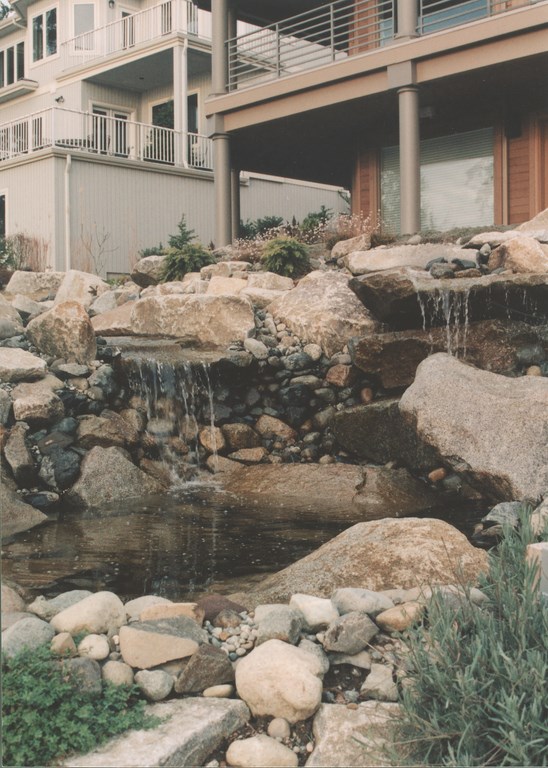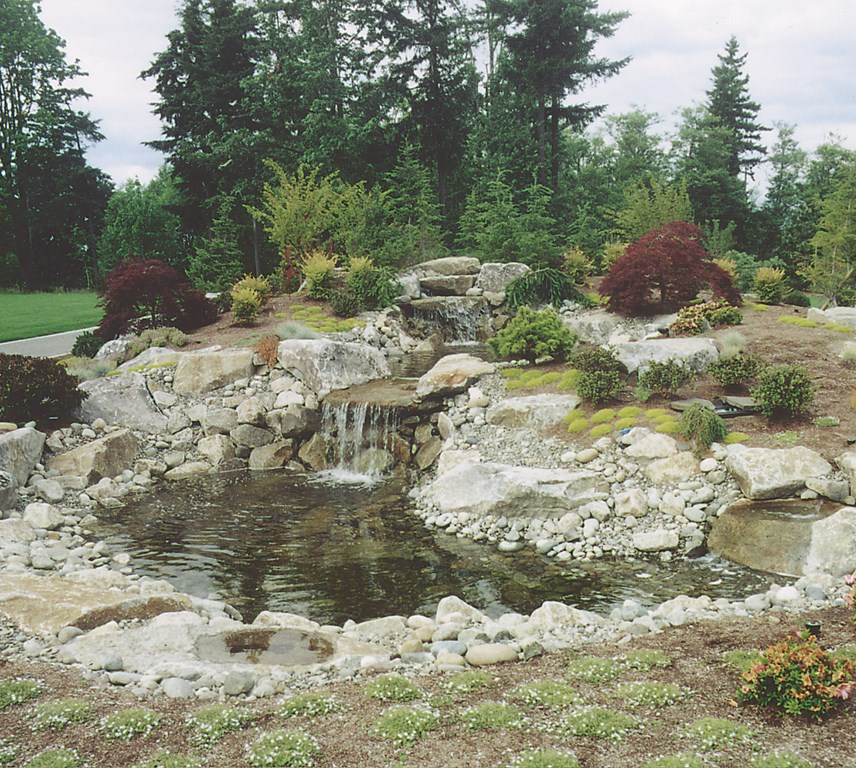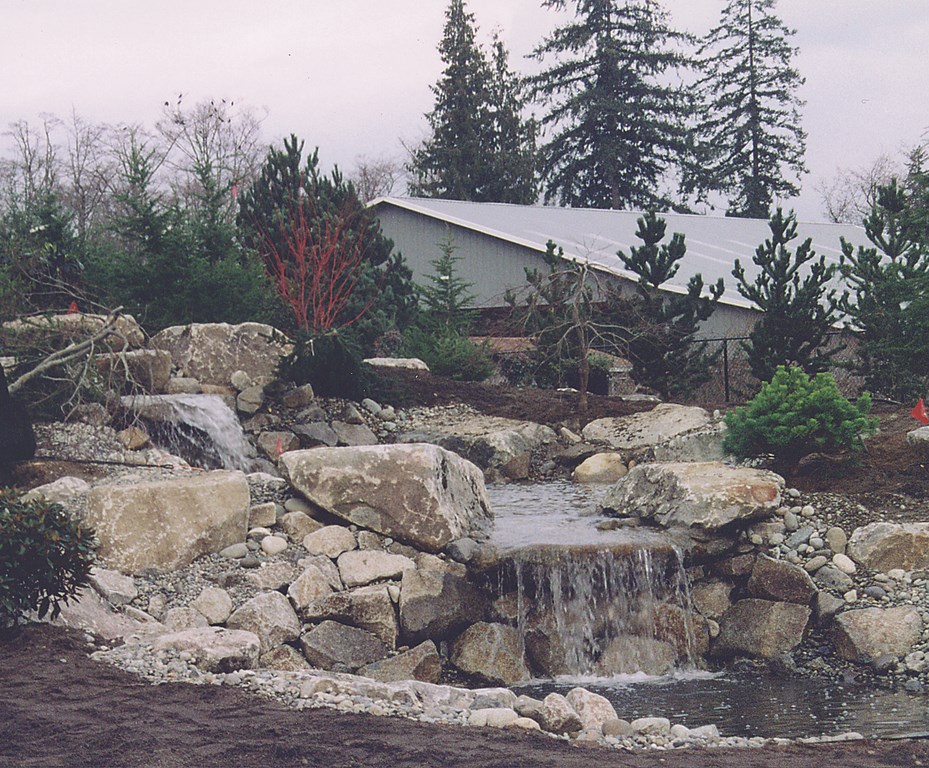Echoes of Grandeur

The Pacific Northwest is full of spectacular scenery. From where I live near the Puget Sound, for example, you can see the Olympic range running along a peninsula to the west and the Cascade range off to the east. Looking southeast, Mt. Rainier is a silent, majestic sentinel silhouetted against an ever-changing sky.
It’s a beautiful place to live and perfect when it comes to design inspiration – especially when your work is creating naturalistic gardens and watershapes.
One of the most spectacular waterfalls in the entire northwest is just a short drive up Interstate 90 from me, a place called Snoqualmie Falls. Local hiking trails are dotted by scores of perennial waterfalls that cascade down mountainsides. For me, there is nothing more refreshing than clambering up a steep grade and rounding the corner to find a misty, shady waterfall. It invigorates the soul and encourages one and all to keep climbing in the hope of seeing even more spectacular scenery.
The attractions of nature and its inherent beauty are much enjoyed by people who live around here. In recent years, I’ve seen a trend toward bringing slices of that grandeur down to a residential scale in gardens that use water in motion as a key feature. It’s the water that makes these small spaces special, drowns out the noise of civilization and creates oases in what might otherwise be uninspired, uninspiring spaces.
NATURAL NOTES
The watershapes for which my clients are clamoring come in all shapes and sizes, from individual cored-basalt fonts to elaborate, multi-pump rock cascades. No matter the scale, the key is the sound and ambience created by falling water – irreplaceable in these gardens and especially inspiring when the work harmonizes with verdant surroundings.
Of course, it’s seldom easy to design and install a convincing natural watershape in the confines of any backyard, let alone one located within easy reach of nature in all its glory. Orientation and placement and contouring are critical when it comes to blending the watershape into its setting. Then there are practical issues, such as the budget and physical factors including whether you have the access you need to bring in large boulders and trees if that’s what the site requires.
|
Recognition Collaboration between designer and installer is key to the success of any quality watershape. In the case of the projects seen in the accompanying article, I bow to the skills of Rob Park of Park Design Associates in Kirkland, Wash. Through the years, I’ve worked with many landscaping contractors. Rob is unsurpassed in his desire and ability to grasp the nuances of waterfall and stream construction – and he does so with an extraordinarily high level of skill and sensitivity. — L.B. |
In my case and in the case of others who stay on the design side of the project, there’s another key to success that must be considered: We need to find landscape contractors who have extensive experience in excavation, liner installation, rock placement, circulation systems and planting.
More important, these professionals must have the ability to see as we see and come to share the vision we have for the project. And it certainly doesn’t hurt if they’re nature lovers, too, and have spent time hiking and walking in the forests and along the region’s magnificent waterways.
When it all works – and, happily, it works often and well – this shared vision of designer and contractor results in beautiful orchestration of the water elements in harmony with the rest of a garden landscape and in accord with the greater regional setting.
To explore the ways this orchestration works and how the various factors listed above come into play, let’s take a look at a selection of projects that have grown out of my own exploration of the waterfalls and waterways of the Pacific Northwest and my personal quest to mirror their compelling beauty.
Making Good
This northwest-facing slope contained a small residence that offered spectacular views of Puget Sound and the mountains. The site, however, was compromised by the faint yet steady sound of cars thumping over the expansion joints of a nearby bridge and more ominously by heavy sub-grade drainage headed toward the sound.
The groundwater problem was so severe, in fact, that the clients developed a master plan that called for relocating the entire residence upslope to a dry, stable site where an existing guesthouse stood. When that project was done and crews removed the concrete foundation of the old home, continuous streams of surface and subsurface water emerged, flowing right through the summer months.
When we were called in on the job, we decided to turn the non-stop water flow into an asset without compromising the natural drainage or the structural stability of the new concrete foundation. We evaluated orientation and placement options and installed a bulkhead with rock steps and extensive drainage, then built a curtain drain around the house and sunk a manhole structure to allow access to a pump basin.
From that basin, subsurface water is now pumped into a small pond above the new home. From the pond, water flows across an alpine rockery and cascades over outcrops adjacent to a large, flagstone patio. Collected into another small pond, the surface water flows down a small creek alongside the patio to the bulkhead. The creek then falls down another drop behind the bulkhead before reaching the sound.
In essence, this perennial watershape does little more than redirect a natural flow, using it to create a musical complement to views of Puget Sound.
Sound and Serenity
This project was all about taking an under-used hillside space and transforming it into an invigorating backyard amenity.
We tucked our work into a slope adjacent to a large deck. There we had just 25 feet of space available for contouring and landscaping around a cascade, and we chose to plant densely both to set off the water and provide the sense of seclusion the clients wanted in their private garden.
Now complete, the waterfeature is visually screened from the street, but it provokes curiosity just the same because the roar of its three-tiered cascade is quite easily heard. And the water is far from remote for our clients and their guests: At the top of the slope, granite steps allow for intimate aquatic interaction, and the mist from the cascade drifts up to the deck – a refreshing relief on hot summer days.
A Dramatic Entrance
 After an extensive home renovation, the owners of this property decided they wanted to enhance its flat, dull entryway. It’s a case where adding some elevation and a waterfeature made all the difference.
After an extensive home renovation, the owners of this property decided they wanted to enhance its flat, dull entryway. It’s a case where adding some elevation and a waterfeature made all the difference.
The area was literally flat – no contouring or real opportunity for any sort of drop. We replaced the asphalt driveway with stamped concrete to create an inviting drive and entry walk. We also built up the center of the existing circular drive and set up a cascade through a cluster of high granite rock outcroppings. The elevation hides the doorway from the street and, with the aid of dense plantings, cuts down on traffic noise.
In the process, the whole entryway and sense of access have been changed. The loop drive and breaks in the elevations provide entry into what is now a private courtyard. The watershape flows toward the front door, thereby adding to the sense of drama and making a strong impression on anyone who uses the front door.
Filling in the Blanks
 The opportunities and constraints with a new residence are always different from the ones we encounter in watershaping for existing landscapes. In this case, a new seven-acre Maple Valley residence was an open canvas for us – and a delightful change of pace.
The opportunities and constraints with a new residence are always different from the ones we encounter in watershaping for existing landscapes. In this case, a new seven-acre Maple Valley residence was an open canvas for us – and a delightful change of pace.
The residence was designed with an outdoor seating area in front, set up adjacent to a covered breezeway that offers access to an auto court at the back of the garage. The circulation, landscape and grading programs were all designed to set up a central island with a watershape that was to lend visual focus to the whole front yard.
Given its central position, we set up the watershape to cascade in multiple directions, facing primarily the entry steps and the outdoor seating area. The sun sparkles off the south-facing cascade, creating a play of light that sets off the residence as well as the perimeter plantings.
And like the majority of the natural waterfalls and waterways found in the region, this watershape offers interactivity by way of a lower pond surrounded by large granite rock outcroppings that double as seating stones and offer an invitation to waders.
Lauchlin R. Bethune is a landscape architect in Kent, Wash. With 20 years of experience in a variety of disciplines including exterior design, watershape design and construction, urban planning, site development and environmental remediation, he is a 1982 graduate of the University of Oregon with a degree in landscape architecture. For the past 11 years, he has run his own firm, Lauchin R. Bethune Associates, and has focused on projects for both residential and commercial clients. His work includes design and project management for all phases of exterior design, including planting plans, hardscape design and sequencing of large residential and commercial spaces.

















